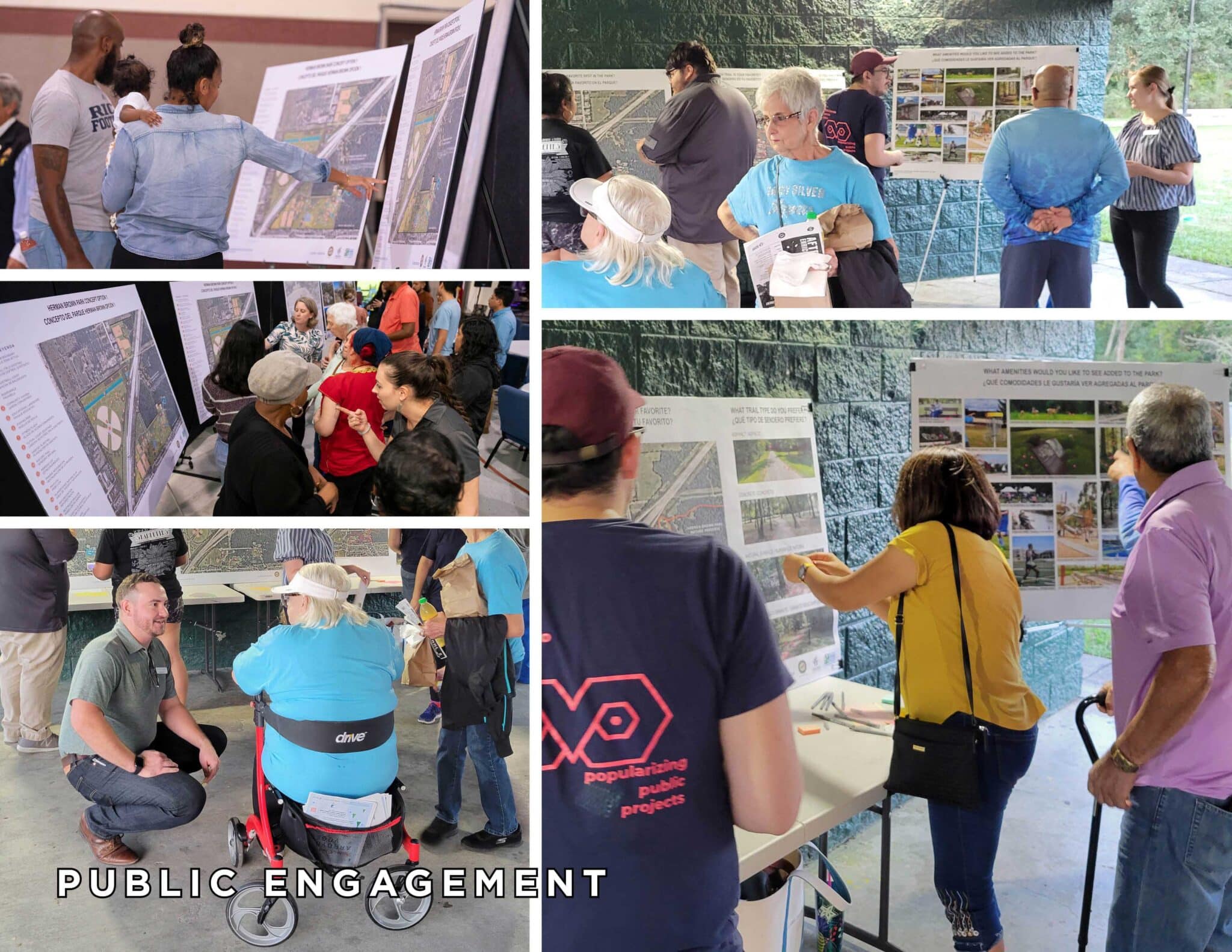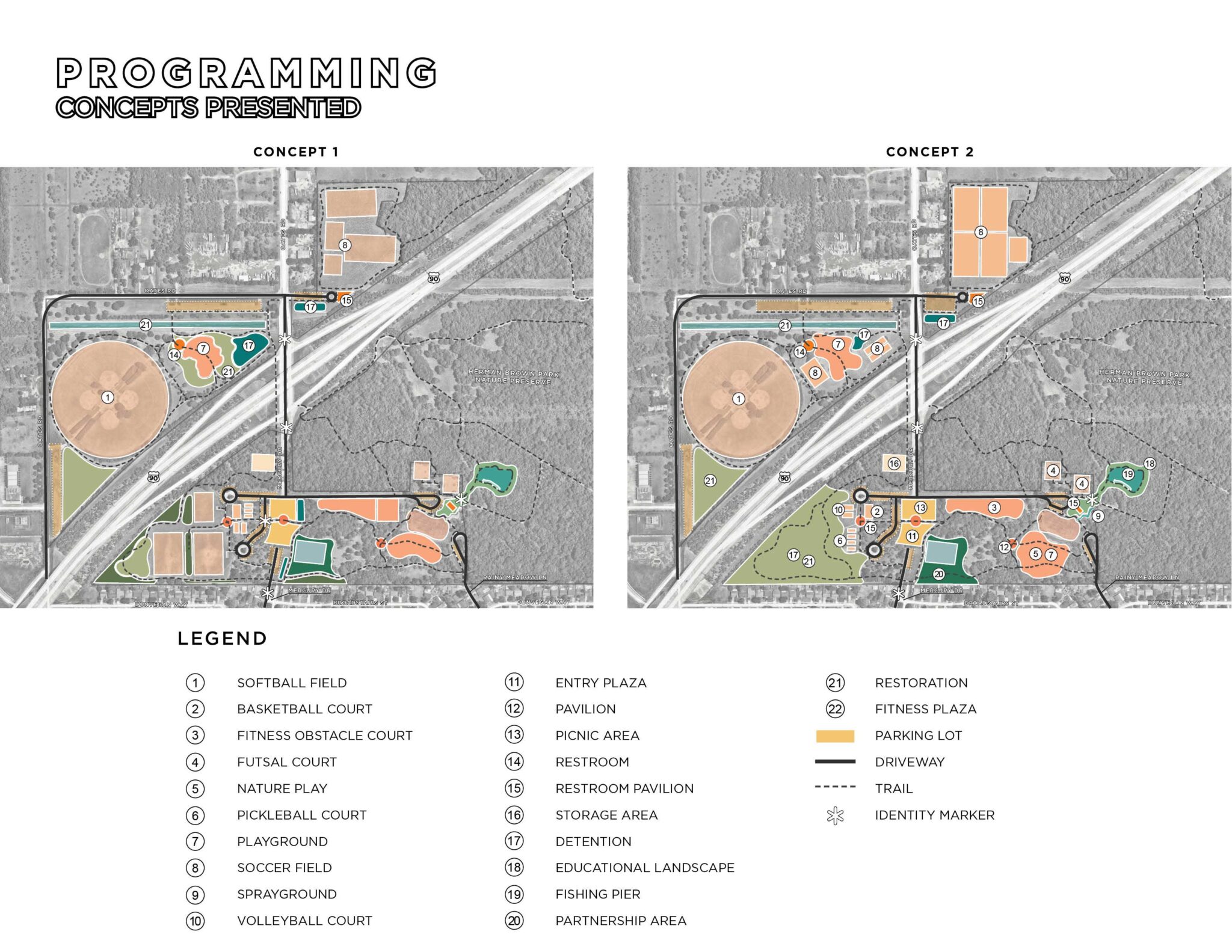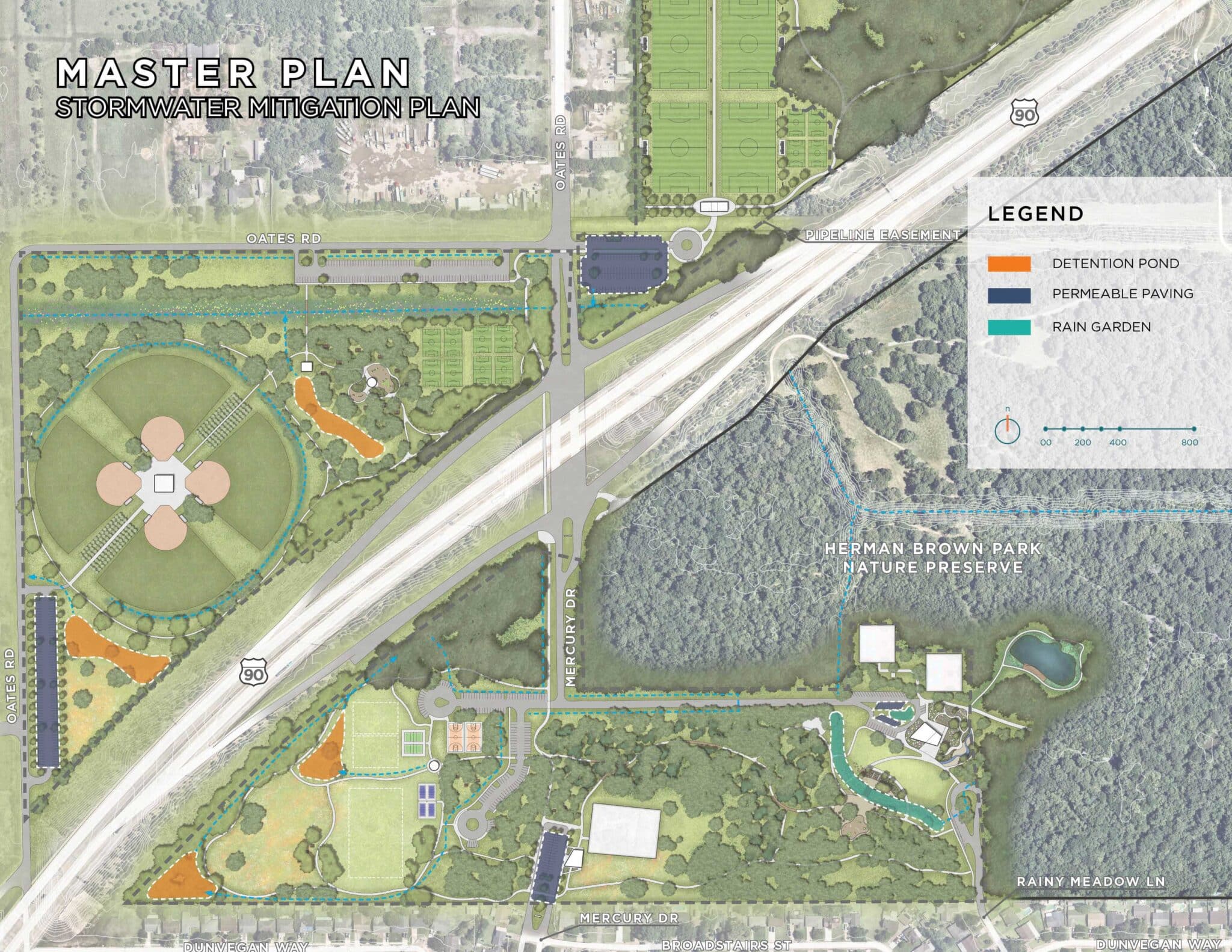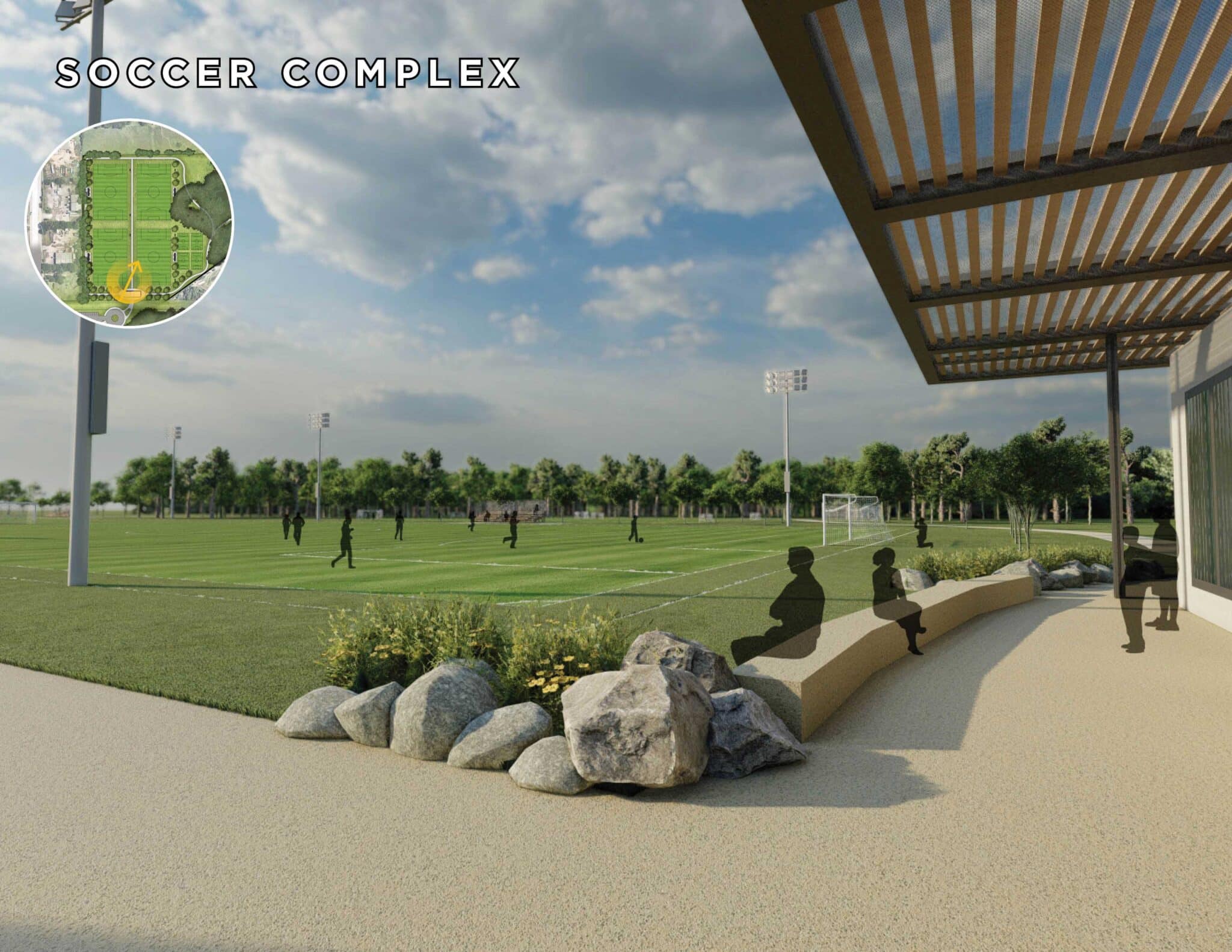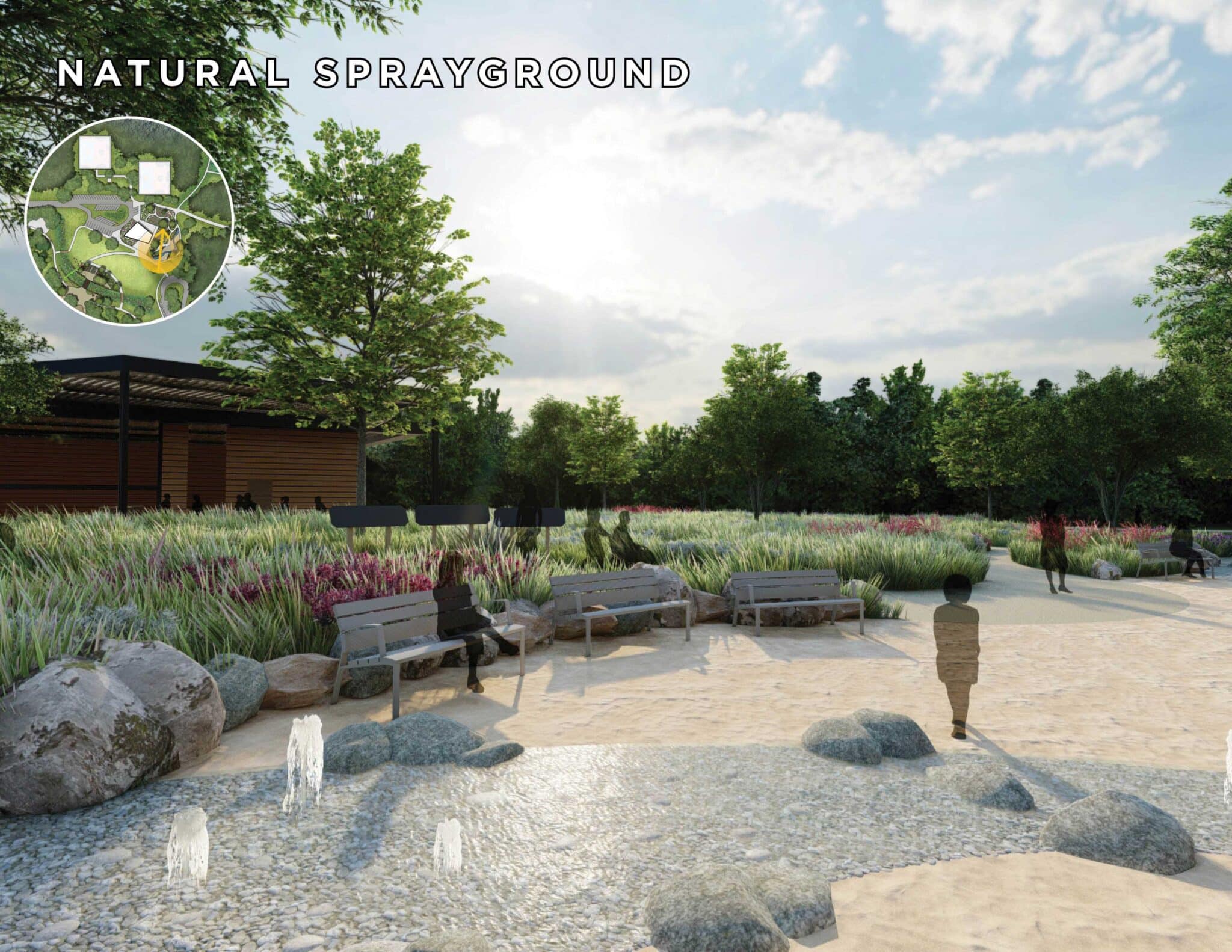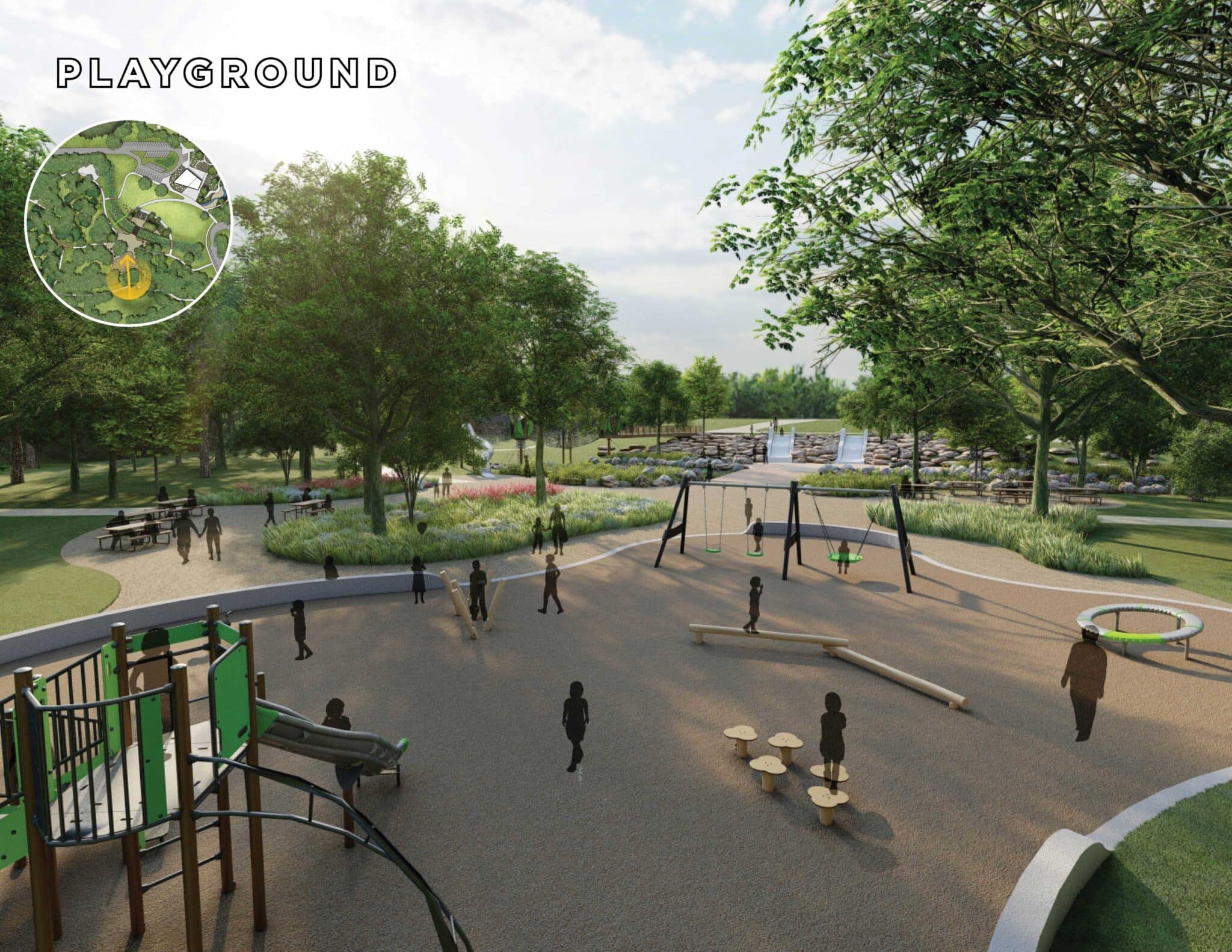CASE STUDY
UNITY IN NATURE: A PARK HARMONIZING FLORA, FAUNA, AND COMMUNITY NEEDS
CLIENT: Houston Parks Board
PROJECT: Herman Brown Park Master Plan
Through innovative and resilient design strategies, the master plan envisions Herman Brown Park to be a safe place to learn, exercise, and relax by seamlessly blending the natural habitat with recreational areas to deliver meaningful experience.
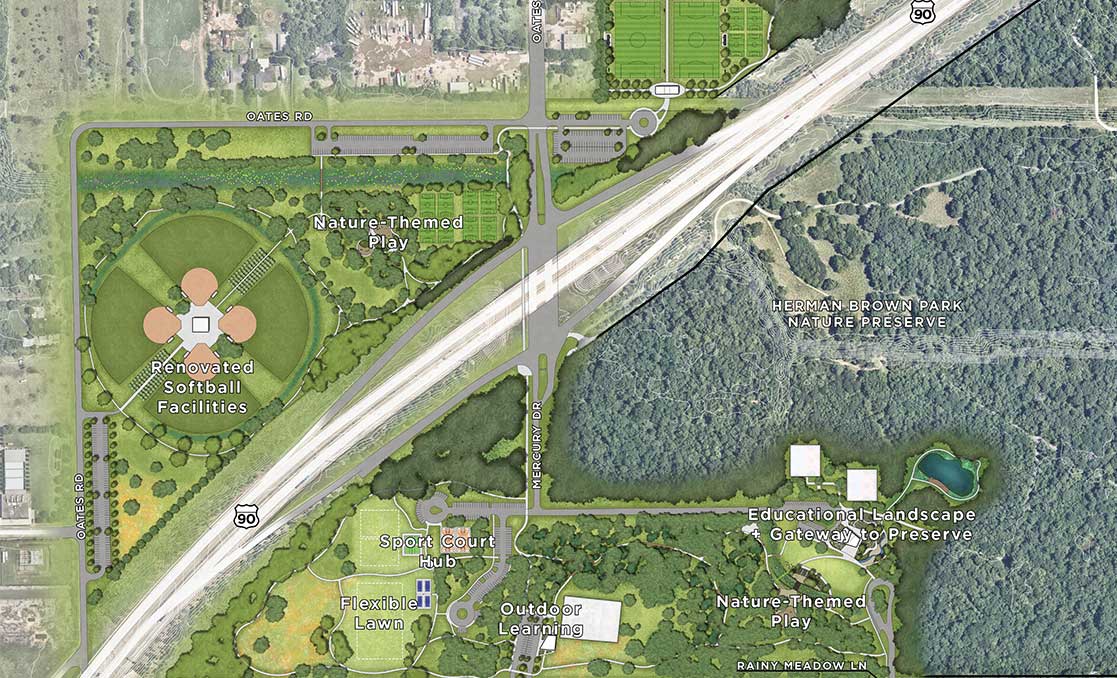
The Scene
Herman Brown Park was integrated into the Houston park system in 1979 via a generous donation by The Brown Foundation. Over the years, the park has become a favorite place within the community and a vital place of respite. Despite the construction of Highway 90 in 2008 creating a physical divide, the park remains a beloved hub within the community. In 2022 the City of Houston passed a Nature Preserve Ordinance protecting 7,423 acres of natural habitat within city parks.
Herman Brown Park has 640 of its 717 acres designated as natural habitat, safeguarding vital ecosystems, water resources, and a rich variety of native and rare plant and wildlife species. The remaining 47 acres are available to be programmed for active use, providing opportunity for a harmonious blend of recreational and ecological spaces. Continuing their legacy and commitment, the foundation funded a master plan study to look at options to reinvigorate the park, establish unity through enhanced connectivity, and create a plan for future development.
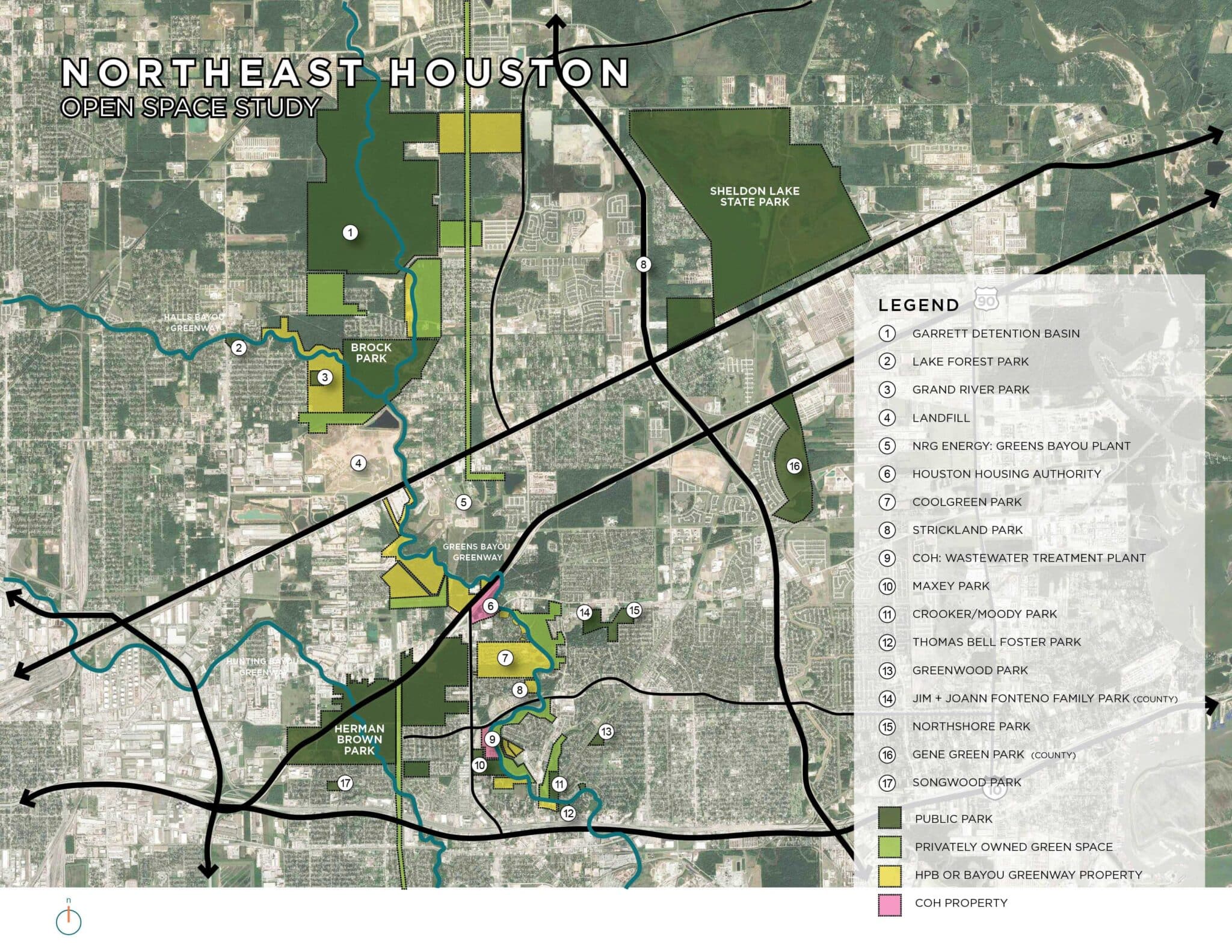
The Project
As part of the initial process for the master plan, thorough evaluations were conducted, such as data gathering, assessment of existing facilities, an ecological assessment, and extensive community input. The ecological site assessment revealed that the park's current condition was typical of urban environments, marked by a moderate to poor state due to increased recreation. Rebuilding the ecological quality and protecting existing ecosystems became a top priority for the master plan.
Additional goals for the plan included an integration of nature play and educational elements, connectivity between the northern and southern portions of the park, improved stormwater mitigation via nature-based solutions, increased safety, and general park improvements to meet the community’s vision and long-term needs. Considering the programming and recreational elements needed by the community and the complex reality of the existing site conditions, the plan would need to balance nature-based solutions, active and passive recreation, natural habitat preservation, safety, and accessibility to create an optimal experience for park users, promoting a healthier, more accessible, and vibrant community asset.
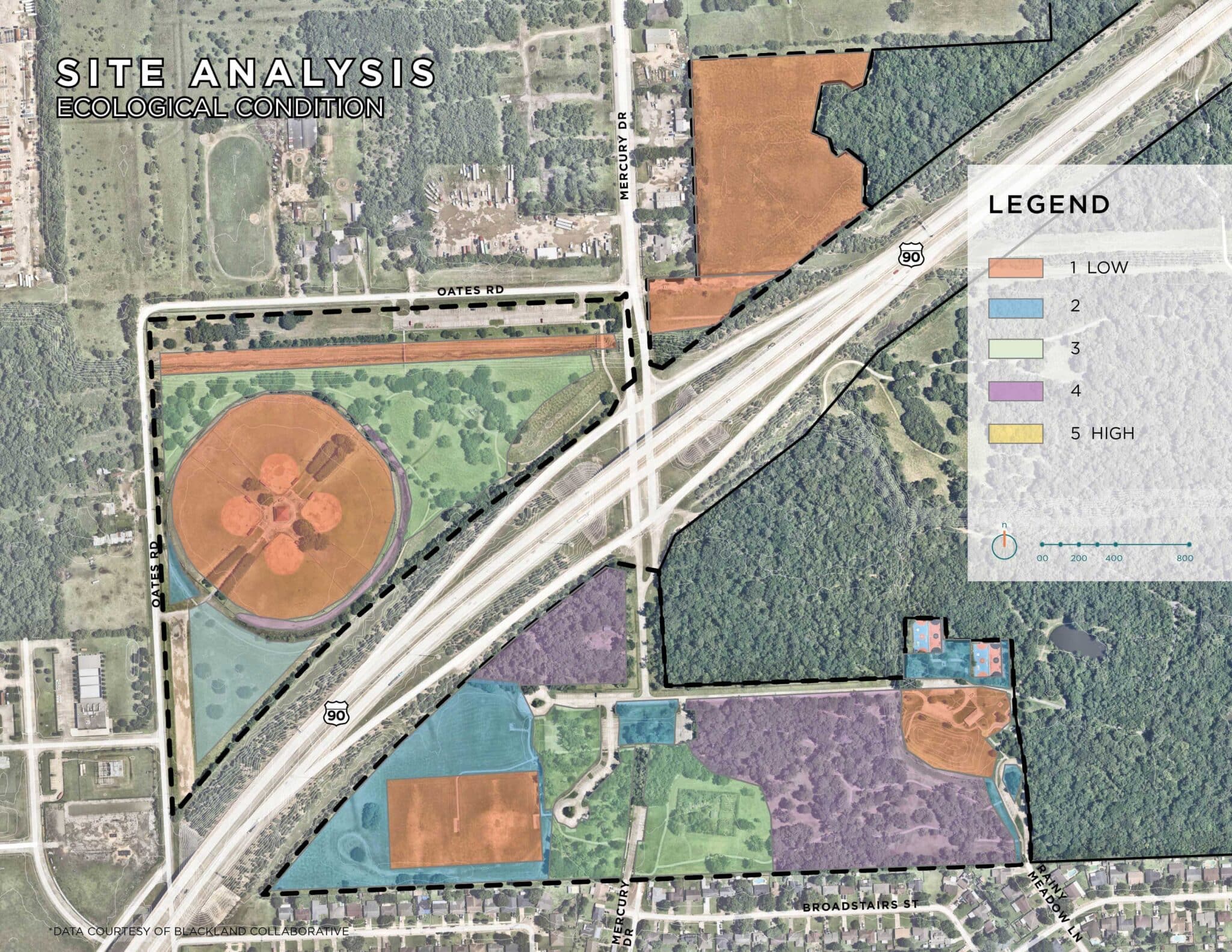
The process
The master plan included a robust collaborative effort among public entities, political jurisdictions, private businesses, the community, and Furr High School. Extensive community engagement was performed to collect feedback, suggestions, and ideas on current and future uses of the park. Given the high number of Spanish-speaking residents, a bilingual approach was taken to remove communication barriers and allow for a diverse and comprehensive approach. A total of six meetings and events were held with more than 200 attendees, and interpreters were available to assist with translated exhibits and interpretation. The outreach also included a survey, social media engagement, flyers, postcards, and banners/yard signs for optimum participation. The social media reach exceeded 10,000, and over 2,000 postcards were mailed to the community for the open house and community meeting.
The collaboration extended to key stakeholders such as the Houston Parks Board, the City of Houston Parks and Recreation Department, Harris County, and the Houston Police Department, to enhance the park's infrastructure, amenities offered, and security. Furr High School has played a pivotal role in this partnership, with its representatives, parents, and students actively participating in the master plan's development. The school utilizes the park for various educational activities, including a community garden and student involvement programs, which foster a deep connection between the students and the natural environment. The school also benefits from work-study opportunities within the park, providing students with practical experience and income. To address safety concerns, the Houston Parks and Recreation Department's Urban Park Rangers and the Houston Police Department collaborated to increase surveillance and patrols, ensuring a secure environment for park visitors. This cooperative approach will not only enhance safety but will foster a strong sense of community ownership and stewardship. Through these partnerships, the master plan harnessed diverse resources and expertise, ensuring the park remains a vibrant and inclusive space that meets the evolving needs of its community.
Also central to the plan is the integration of nature-based solutions to enhance stormwater mitigation, which will help sustain the park's ecological balance and vitality. Low-impact development strategies, such as bioswales, raingardens, and permeable paving, will be instrumental in boosting habitat health and resilience. The ecological assessment also revealed a high presence of invasive understory plant species that have diminished plant diversity and habitat value. The plan recommends replacing invasive species with native plants, fostering a resurgence in biodiversity, and creating a more welcoming habitat for local wildlife. These techniques work together to manage stormwater efficiently, reducing flood risks and improving the water quality of the nearby bayou. Given the park's location within a floodplain and its proximity to the bayou, stormwater mitigation is critical to the park and surrounding neighborhoods. These comprehensive efforts will set a benchmark for ecological resilience, environmental stewardship, and contribute to the overall enhancement of the region’s natural landscape and water quality.
In addition to the ecological considerations for the park, there was an emphasis on new playground equipment, walking trails, safe pedestrian crossings, a splash pad, updated site furnishings, and two playgrounds. These enhancements are expected to boost community engagement by enhancing the park’s amenities to better meet the community’s needs now and in the future. The addition of new amenities and improvements in infrastructure will foster increased physical activity, contributing to enhanced public health and quality of life.
The result
The Herman Brown Park master plan illustrates a comprehensive approach to community park development, offering a blueprint that balances nature-based solutions with recreational opportunities, habitat preservation, safety, and accessibility to create an optimal experience for park users. This thoughtful integration ensures the park is not just a leisure and recreation area but also a hub for ecological sustainability and community interaction.
A transformative approach was taken to leverage the park's unique division by Highway 90 by creating a vibrant sports park north of the transportation corridor and a community park to the south. In the northern section, the introduction of a tournament-level soccer complex, expansive walking trails, nature-inspired playgrounds, a flexible law, a splash pad, and conveniently located restrooms promotes physical activity and social interaction within a well-organized sports hub, while providing access to needed amenities. This transformation is crucial for boosting public health by encouraging active lifestyles and providing accessible fitness facilities for all ages.
Meanwhile, the southern section serves as a gateway to the nature preserve, introducing increased community-focused spaces that invite exploration and connection with nature. This area is not only pivotal for environmental education but also for mental well-being, offering serene spaces for relaxation and reflection. By improving access to natural areas, the plan ensures that communities can benefit from the park’s restorative environment. Innovative design strategies seamlessly integrate ecological improvements with active recreational areas, creating a park that is both resilient and multifunctional.
The plan also capitalizes on the site's strengths, including a healthy overstory and diverse plant species in certain areas, which contribute to effective stormwater absorption and provide habitats for pollinators. Opportunities to enhance habitat value are plentiful. Prairie restoration, stormwater mitigation, and low-impact development initiatives are just a few strategies aimed at improving the site's ecological resilience. Additionally, strategic plantings and nature play elements are included to foster environmental stewardship and educational engagement. The master plan outlines several recommendations to bolster these efforts: designated planting areas to enhance native vegetation, nature-based solutions to optimize stormwater management and educational elements that encourage community interaction with the environment. By creating a gateway to the nature preserve, the project also aims to improve trail networks and accessibility, ensuring the park remains a resilient and sustainable resource for future generations.
Additional key features within the master plan include permeable parking surfaces that reduce hydrologic impact, and native landscapes designed to optimize water absorption, creating sustainable ecosystems that require minimal maintenance. The project also focuses on accessibility improvements with the addition of pedestrian pathways beneath Highway 90. This ensures a safer and more convenient route to the park’s southern areas, fostering greater connectivity within the community. The replacement of the fishing pier, coupled with new aquatic plantings and an educational landscape, enriches the park's ecological value. These elements invite visitors to interact with and learn about the diverse natural environment, promoting environmental awareness and stewardship.
The success of the park's master plan, however, was significantly bolstered by fostering strong relationships with key community members who championed the project. These individuals were instrumental in drawing people to outreach events and promoting the survey, ensuring a thorough and inclusive engagement process. Their active involvement, alongside stakeholders, in planning and programming exercises, ensured the selection of a concept that truly represented the community's vision for Herman Brown Park. With an estimated cost of $40 million, a complete implementation of the plan will require not only continued community and stakeholder support, but also a diverse range of funding solutions. The plan has been strategically divided into four phases to ensure a systematic approach to its implementation with both short-term and long-term recommendations. A phased approach allows for gradual and strategic development, aligning with budget availability and minimizing potential disruption for park users. This thoughtful strategy ensures that improvements are sustainable and responsive to both current and future community needs, making Herman Brown Park a vibrant, inclusive, and educational hub for generations to come. Park projects succeed when community members are empowered to actively shape their development and outcomes.
Overall, the plan provides a framework for a vibrant and immersive environment where users can engage in various activities, from enjoying serene nature trails to participating in sports and community events, strengthening community ties and enhancing well-being. The Herman Brown Park master plan highlights the transformative potential of parks to meet ecological, social, and recreational needs. By prioritizing ecological assets, enhancing recreational opportunities and fostering community engagement, this project demonstrates how parks can evolve into dynamic spaces that preserve natural beauty while improving the quality of life for all.
.

